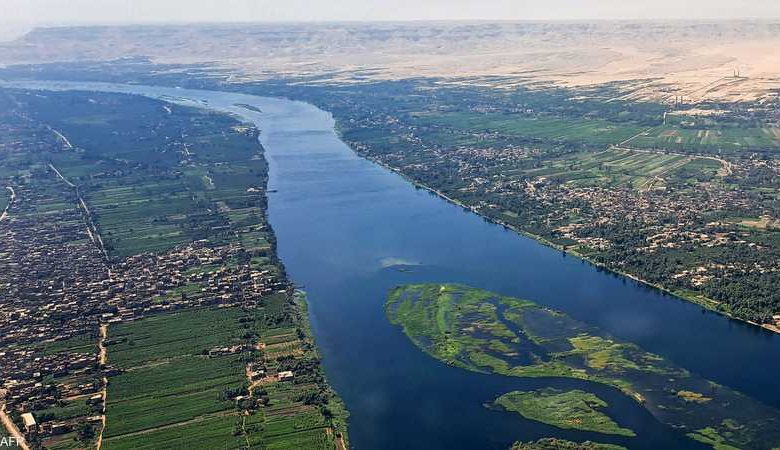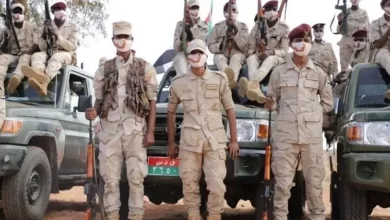Reports
The Nile: Struggles for Wealth and Power (2-2)

Sudan Events – Agencies
Sudan’s initially neutral stance toward the Renaissance Dam was driven by the benefits it expected from the dam, primarily the opportunity to fully utilize its 18.5 billion cubic meters share of Nile waters. Due to limited storage capacity and silt accumulation in its reservoirs, Sudan has been unable to use over 6.5 billion cubic meters of its share, with the excess water flowing north to Egypt, increasing Egypt’s share to 62 billion cubic meters (55.5 + 6.5). With the operation of the Renaissance Dam, Sudan would be able to regulate floodwaters throughout the year, allowing for an expansion of agricultural areas and an increase in crop cycles to three per year.
A chart shows South Sudan’s significant share compared to Sudan, Egypt, and the UAE (excluding virtual water from food imports that require vast water resources for production). Source: World Bank
However, these promises are now in doubt after the approval of the Entebbe Agreement by the Nile Basin countries, which could lead to initiatives that may cause Sudan to lose the primary benefits of the Renaissance Dam.
In recent years, new regional players have emerged in the African landscape, seeking to gain a share of the Nile’s waters through involvement in Nile Basin management, intersecting with food security challenges faced by these countries. The regional influence of the UAE began to take shape during the Arab Spring revolutions and the subsequent political and security chaos. Contrary to first impressions of this oil-rich state, the UAE faces an existential challenge regarding food security, especially with its severe water scarcity, low rainfall, and highly limited groundwater. The country is covered entirely by desert.
Ironically, the UAE has the highest per capita water consumption in the world. The average Emirati consumes approximately 2,270 gallons (8,600 liters) of water per day. As mentioned earlier, the water footprint largely consists of water consumed in various food products, with meats being the largest consumer. Luxurious cotton clothing and high-end industrial products also consume enormous amounts of water. Given the country’s water scarcity, the high water footprint indicates that the vast majority of this water consumption is imported from abroad in the form of agricultural products and animal goods, indicating a high quality of food, clothing, and daily services enjoyed by Emiratis.
Abu Dhabi has played a prominent role in East Africa. In South Sudan, the UAE has strengthened future partnerships with the young state. Notably, in April, news emerged of a $13 billion loan from the UAE to South Sudan under the Ham
Bin Khalifa Al Nahya Projects.
Department (DOP HBK), to be repaid through South Sudan’s oil exports over 20 years, with a reduced price of $10 per barrel below the global market price. This deal sparked considerable debate among observers.
However, the timing of this deal coincides with the near completion of the fifth filling of the Renaissance Dam and South Sudan’s ratification of the Entebbe Agreement, raising accusations that the UAE is wooing Juba to pave the way for the redistribution of Nile waters, giving the UAE opportunities to manage the Nile’s water resources. Supporting this is the fact that South Sudan has abundant water resources and is not negatively affected by the current water-sharing arrangements, which has led it to overlook its water rights since its independence. South Sudan has long ignored its share of the Nile waters—18.5 billion cubic meters allocated to Sudan before the secession—and the issue is expected to resurface soon.
Additionally, there have been reports of a planned road connection between Ethiopia and South Sudan, spanning 220 kilometers, along with news of a planned oil pipeline from South Sudan through Ethiopia to the port of Djibouti, which continues to offer its ports for Ethiopian investment. The establishment of this project would lead Sudan to lose its revenue of $23 per barrel for transporting South Sudan’s oil to the Bashayer Port.
All of this suggests that the benefits that led the South Sudanese government to sever its strong relationship with Egypt were significant. Juba abandoned Cairo, the largest military power in the region, despite all the investments Egypt has made in water resource management and the frequent diplomatic visits from high-level Egyptian officials to Juba over the years. These visits included President Abdel Fattah El-Sisi’s 2020 trip and the recent visit by the Egyptian Minister of Water Resources and Irrigation in June, during which water and climate forecast projects were inaugurated.
On the other hand, the UAE continues to expand in East Africa, supporting Ethiopia’s efforts to complete and operate the Renaissance Dam and investing heavily in agriculture, technology, and food security.
Recently, Abu Dhabi has expanded its influence by providing military support to the government of Prime Minister Abiy Ahmed in its war against the Tigray rebels, reportedly tipping the scales in favor of Addis Ababa by supplying drones, according to unverified reports in some Arab media outlets. In another chapter of its involvement in the Horn of Africa, the UAE has sought to establish a foothold in “Somaliland,” the self-declared republic that has been independent from Somalia since May 1991. Abu Dhabi took this step following the collapse of its partnership with Djibouti, which accused the UAE of pursuing colonial policies through its presence at the capital’s port. The UAE quickly moved to make up for its loss of a foothold on the Gulf of Aden by establishing another at Berbera Port in Somaliland, without concern for the legitimacy of its presence. It proceeded to build a military base in the area and developed the port with an investment exceeding $300 million, along with another $100 million for a road linking the port to the capital, Hargeisa, extending to the Ethiopian border. Ethiopia, a landlocked country, views this development as a lifeline, allowing it to access the Gulf of Aden. This has long been a goal for Ethiopia to revitalize its economy and trade, as it has been a landlocked country since Eritrea gained independence in 1993.
This paved the way for Ethiopia to boldly sign a memorandum of understanding with Somaliland in January of this year, granting Ethiopia access to a 20-kilometer stretch of the Gulf of Aden coastline for 50 years to develop a commercial port and establish a military base. In exchange, Ethiopia recognizes Somaliland’s independence and grants it a significant share in Ethiopian Airlines. This move angered the Somali Republic, which views Somaliland as a part of its territory and insists that it must return to its sovereignty.
The overlapping roles and the multiplicity of interests have complicated the East African scene. Ethiopia plays one role in the Horn of Africa and another in the Nile Basin. As a result, Egypt has strengthened its military cooperation with Somalia by signing joint defense agreements, following which the Egyptian armed forces sent military cargo planes in late August carrying arms shipments as part of the military cooperation protocol with Somalia. Ethiopia views this as an escalation and a threat to its national security. Observers see it as an opportunity for Egypt to establish a military presence near the Ethiopian border to deter any action that might threaten Egypt’s share of Nile waters, especially as Egypt is skeptical of Ethiopia’s intentions regarding the management of the Renaissance Dam during drought and prolonged drought years, which may intensify with global warming, climate change, and the predicted occurrence of the “La Niña” phenomenon in the coming years, potentially affecting rainfall in East Africa.
While the UAE supports Ethiopia, Somaliland, and the Rapid Support Forces in Sudan, Saudi Arabia, Egypt, Turkey, and Eritrea support Somalia and the Sudanese army, deepening the divide among regional actors and hindering efforts to create calm in the region.
The regional ambitions concerning the Nile Basin are inseparable. The sources of water are in Ethiopia and the equatorial lakes region, the vast arable lands are in Sudan, and the relatively advanced infrastructure in Egypt allows it to convert agricultural products into industrial investments and tourism ventures, as planned in the “Ras El-Hikma” project in Egypt, funded by Emirati investments exceeding $150 billion, with Egypt receiving only 35% of the profits. Thus, the UAE has gained control over the threads of the game, surrounding the Nile Basin countries from the north, south, east, and west.
A map of the Horn of Africa, including Somalia and Somaliland, overlooking the Gulf of Aden. Source: France Media Monde.
This Emirati expansion comes amid China’s decline in Africa, as it reduces the size of its loans. This decline has created a vacuum that the UAE has not hesitated to fill by increasing its investments in Africa. These investments span agriculture, renewable energy projects, mining, and ports, in various commercial and strategic roles. The UAE’s replacement of China has prompted Western governments to turn a blind eye to what Abu Dhabi is doing in the region, as the UAE’s presence in Africa curtails China’s expansion, thus playing a role aligned with Western interests in limiting China’s global ambitions, especially regarding mining and oil production activities, in which the UAE has been deeply involved in countries like the Democratic Republic of the Congo and Angola.
Thus, the regional player looks at the Nile Basin countries as water societies that produce its water, grow its crops, ensure its food security, protect it from the harsh desert environment, and guarantee its citizens’ prosperity and luxury. In return, it produces oil relentlessly, investing every dirham from it in creating ambitious and sustainable projects that ensure its survival and sovereignty in the post-oil era. By doing so, it recreates the colonial era in a hydropolitical guise. Undoubtedly, the ambitions of these countries, and those behind them, obstruct the path to a fair and ethical management of resources that meets the needs of all the region’s inhabitants.



